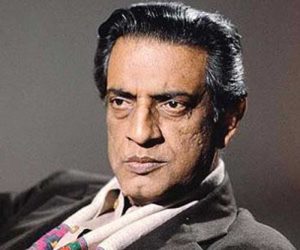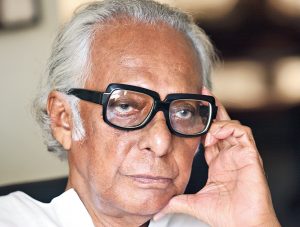 By Satya Narayan Misra in Bhubaneswar, May 17, 2023: Mrinal Sen, the original gadfly of Indian cinema would have turned 100 on Monday. He belongs to that rare breed of parallel Bengali cinema who along with Satyajit Ray, Ritwik Ghatak took Bengali cinema out of claustrophobic maudlin, sentimentality, and formula format by creating a syntax for quality cinema anchored on the Indian soil.
By Satya Narayan Misra in Bhubaneswar, May 17, 2023: Mrinal Sen, the original gadfly of Indian cinema would have turned 100 on Monday. He belongs to that rare breed of parallel Bengali cinema who along with Satyajit Ray, Ritwik Ghatak took Bengali cinema out of claustrophobic maudlin, sentimentality, and formula format by creating a syntax for quality cinema anchored on the Indian soil.
They captured the national imagination till the 1980s and received fulsome global recognition for their outstanding oeuvre, cinematic excellence, and feel for indigenous rootedness.
Ritwik, the maverick, started in 1950, Ray in 1955 with a big splash with Pather Panchali, and Mrinal, in the same year with Raat Bhore, a modest film. The triumvirate had immense human compassion, and understood the socio-economic ethos of Bengal extremely well; its famine of 1943, partition in 1947, widespread crippling poverty, and Naxalism of the 70s.
While Ray arrived in the global firmament with his The Apu Trilogy, Ghatak received critical acclaim with Ajantrik 1957 and popular approbation with Madhumati in tandem with Bimal Roy, Sen is a late bloomer in terms of achieving success and acclaim. His first taste of both popular and aesthetic appeal came with Bhuvan Shome 1969, set in the rural landscape of Gujarat.
The film’s protagonist Utpal Dutt, essaying the role of a railway big boss is shown fighting an irate buffalo. Rescued by a surreal-looking Suhasini, whose husband was caught for minor corruption by Dutt, the film captures the languid beauty of the countryside, a confluence between class & mass, and looks benignly at petty corruption as a law of nature! An undercurrent of naughty nihilism permeates the movie.
Interestingly Amitabh Bachan gave the voice-over for a princely payment of Rs 300! Calcutta 71, released in 1972 captures the dirty underbelly of poverty in its most candid and ruthless manifestation. He abdicates the lyricism shown by Ray in his films like Ashani Sanket and Pratidwandi. Working in the backdrop of swirling Naxalis, Sen showed how poverty is dehumanizing, and bereft of dignity. No other film captures the restlessness of youth as did Calcutta 71 or Interview, a later film.
Padatik made in 1973 completed his trilogy and pays unabashed homage to Marxism. Ek Din Pratidin (1979) catapulted Sen to dizzy heights. It mocks at conventional morality and unmasked the hypocrisy of the middle class when the bread-earning daughter of the house returns home very late and is ruthlessly questioned. The film does not provide any answer. In terms of its aesthetic inscrutability foiling moral platitudes, Ek Din Pratidin towers above the rest of his movies.
 Unable to comprehend the end, a befuddled Ray called him to know where the girl was. Mrinal’s response was: I do not know, which captures how the master of details differs in his cinematic approach from the firebrand maverick. Akaler Sandhane (1982), another masterpiece, captures how a film unit in a village is trying to capture the flavor of the Bengal famine of 1943 & finds no difference between then and now; between reel life and real life, if caught in the throes of extreme poverty. Sen was truly an iconoclast and. ruthlessly candid.
Unable to comprehend the end, a befuddled Ray called him to know where the girl was. Mrinal’s response was: I do not know, which captures how the master of details differs in his cinematic approach from the firebrand maverick. Akaler Sandhane (1982), another masterpiece, captures how a film unit in a village is trying to capture the flavor of the Bengal famine of 1943 & finds no difference between then and now; between reel life and real life, if caught in the throes of extreme poverty. Sen was truly an iconoclast and. ruthlessly candid.
But the film that takes him to the vortex of cinematic appeal is Khandhar (1984). Based on a short story written by Premendra Mitra, the film captures poignantly the desolation of a bedridden mother and a doting daughter, inside a deserted and. decrepit mansion. They wait in vain for a young man to come and rescue the girl, played with unusual panache by Shabana Azmi. An unspoken whiff of romance, a wisp of a mirage, a cloying tale turns into an exquisite gem in the hands of Mrinal.
Khandhar marks a synthesis of Ray’s epic movie Jalsaghar, and the poignancy of Ghatak in Meghe Dhaka Tara. The three maestros seemed to be caught in the cobweb of human desolation, with exceptional individual artistry backed by riveting acting by the protagonists. Ray, Ghatak, and Mrinal belonged to a Bengal where Marxism was tempered by the humanism of Tagore. Sen was unabashedly leftist in his leanings and did not pull any punches while depicting the innards of poverty.
But he could be subtle as he demonstrated in Ek Din Pratidin. If Ray was a humanist, Ghatak was an iconoclast & Sen was an anarchist. But those who worked with him constantly recount about his loquacity and unfailing hospitality at home. He could be candid to a fault. When Dilip Kumar greeted him with: “Kemon Achen”, he said: That’s not the way it’s said!
He could be a gadfly, but a hero to several redoubtable directors like Ben Bengal, Adoor Gopalakrishnan, Goutam Ghose, and Girish Kasaravalli who doted on him. He had a pan-India appeal! He directed an Oriya movie, Matira Manisha (1966) based on a novel by noted novelist Kalandi Panigrahi. His artistic rendezvous continued with Odia writers when he made Mrigayaa in Hindi, based on short story by Bhagabati Panigrahi.
It’s a poignant tale of a tribal in captivity convincingly portrayed by Mithun Chakraborty. In Padatik (1973) , the tail end of his trilogy Calcutta 71, Interview, he makes a synthesis of two rebels, a political activist escaping the prison van (Dhritiman Chatterjee) and a sensitive young woman (Simi) who shelters him. He called himself a ‘private Marxist’.
 The indifference of the middle class, the apathy of the governing class, and the searing inequality that pervades make Mrinal Da a vocal mascot of the hoi polloi. Nandita Das writes Mrinal Da will be remembered for:’ Asking the hard questions that prick our conscience and telling stories of ordinary people who are increasingly becoming invisible.’
The indifference of the middle class, the apathy of the governing class, and the searing inequality that pervades make Mrinal Da a vocal mascot of the hoi polloi. Nandita Das writes Mrinal Da will be remembered for:’ Asking the hard questions that prick our conscience and telling stories of ordinary people who are increasingly becoming invisible.’
In his Memoir Always Being Born released today, he writes ‘I am a filmmaker by accident and an author by compulsion’. He was part of the great triumvirate of Bengali cinema, who along with Ray and Ghatak, founded the rebellious Indian New Wave tradition which was carried in Hindi cinema by Shyam Benegal in Ankur (1974) & Malayalam cinema by Adoor Gopalkrishna in Swayamvaram (1972). Srijit Mukherji, a brilliant director of present times made Autograph in 2010 as an homage to Satyajit Ray’s Nayak made in 1966.
He repeats his tributes by making Padatik as a centenary tribute to Mrinal Sen’s film of the same name made in 1973. The dystopia of the 70s and the angst of the hoi polloi which Sen portrayed still persist in our society. Mrinal Sen’s sharp lens to unmask the hypocrisy of the middle class, Ray’s classical lyrism to showcase the innards of poverty and Ghatam’s anguish about displacement & alienation would remain enduring cinematic legacy. Mrinal at 100 will continue to a beacon of hope for the underprivileged & discerning viewers.
Prof Misra is a cinema buff


Leave a Reply
Be the First to Comment!